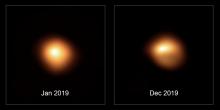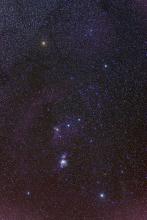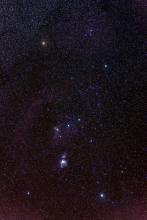Listen to today's episode of StarDate on the web the same day it airs in high-quality streaming audio without any extra ads or announcements. Choose a $8 one-month pass, or listen every day for a year for just $30.
You are here
Orion Rising
The longer, colder nights of late autumn bring one of the great skywatching treats of the year: the return of Orion to prime time. The hunter is in good view in the east and southeast by 9 o’clock, and climbs high across the sky later on.
The constellation’s most prominent feature is the hunter’s belt — a short line of three fairly bright stars. As Orion rises, the belt extends almost straight up from the horizon.
Two of the brightest and most impressive stars in all the night sky flank the belt. Orange Betelgeuse is to the left of the belt, with blue-white Rigel to the right.
Both stars are supergiants — they’re much bigger, heavier, and brighter than the Sun. Betelgeuse is the bigger of the two. If it took the Sun’s place in our own solar system, it would engulf half of the planets — Mercury, Venus, Earth, and Mars — and perhaps even the next one out, Jupiter.
Such massive stars burn through the nuclear fuel in their cores in a hurry. Betelgeuse is only about 10 million years old, compared to four-and-a-half billion years for the Sun. Yet it’s already near the end of its life. Within the next couple of million years, it probably will explode as a supernova, briefly looking as bright as the full Moon.
Rigel is about the same age as Betelgeuse, so it may soon puff up and get redder, just as Betelgeuse has. It, too, then will explode as a supernova — briefly adding to the luster of beautiful Orion.
Script by Damond Benningfield





